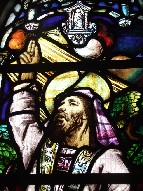| |
|
St
Andrew, Kilverstone
 |
|
The
ruin of Thetford in the 1950s and 1960s by
housing developers, not least the Greater London
Council, has left it a pretty awful place. Once a
small town of barely 5,000 people, it now has
almost eight times that number, mosly in bland
former council estates along clogged roads which
hem in the historic centre with its modern
shopping precinct. But on the eastern outskirts,
just behind the Tesco superstore, is one of
Norfolk's prettiest little churches. Kilverstone
Hall will be familiar to a generation of East
Anglian children as home to a lovely zoo which
specialised in exotic monkeys. But the zoo went
bankrupt in the 1990s, and the monkeys have moved
on. Today, that part of the park not
overtaken by superstores has become a business
centre, but beyond the Hall the view is as lovely
as ever. Visitors will remember the idiosyncratic
water tower designed as a kind of late Victorian
castle turret. But more special is the delicious
Art Nouveau lychgate in the corner of the fields,
which leads through into the graveyard of the
round-towered St Andrew, sitting in the fields a
quarter of a mile from the nearest road.
|
St Andrew
is a charming building, lovely of proportion, a squat,
castellated round tower against a heavily restored Norman
church. The south doorway is original, but the other
Norman features, the west window and the tub-like font
inside, are an 1850s pastiche.
We came
here to find that a Flower Festival was in progress. I
used to be wary of visiting churches on these occasions,
but I've come to find that the bedecking is rarely
intrusive. It usually doesn't cover up anything
important, unless the church has a significant font or a
rood screen, and I knew this was not the case with
Kilverstone. We stepped into the tiny nave to see that
the displays were not much bigger than you'd find for a
typical wedding. Another reason I've warmed to flower
festivals in recent years is that they do give you a
valuable insight into the mind of the parish. In the last
few months, I had visited two churches in Suffolk holding
flower festivals, and had been fascinated by the treasure
trove of local historical items which the people had
collected together. One festival had been themed on the
subject of the 1950s, while the other had depicted
'weddings through the decades'. Both were excellent,
without spoiling an exploration of the church itself. The
items of interest were not the flowers, of course, but
the photographs, books, clothes and the like which they'd
used to augment the displays.
The other
thing I like is that you get to meet local people, and
there's no suspicion about your visit. They actively want
you to take photographs. The two ladies on duty here were
very accommodating, turning off the bright lights so that
we could photograph the glass, and even offering to move
a display, which I wouldn't countenance, of course. The
theme was 'United Nations', and each display depicted a
different country. There were objects which you might
associate with the country in question: there were clogs
for Holland, for instance, and a beret and onions for
France. It was all cheerfully done. I couldn't help
smiling, especially on overhearing a conversation between
two other visitors:
First
Lady: "This one represents Japan."
Pause.
Second Lady: "It's a bit minimalist,
isn't it?"
First Lady: "Well, she did go to
Art School."The jewel of St Andrew is
the gorgeous Arts and Crafts window on the south
side of the Nave. Mortlock thought it was an
early work of Leonard Walker. A curiosity is the
Royal Arms of George I carved in plaster above
the tower arch. The inscription says that they
were the gift of Charles Wright in 1716. Some
roundels on the north side depict the crucified
Christ with the Blessed Virgin and St John. At
first sight, I wondered if they were fragments of
older continental glass worked into a new
arrangement, but I think they are probably late
Victorian.
Nine
lost boys are on the war memorial. They are also
remembered on a beautiful Art Nouveau wellhead,
back up on the road to East Harling.
|
|
 |
|
|
|
